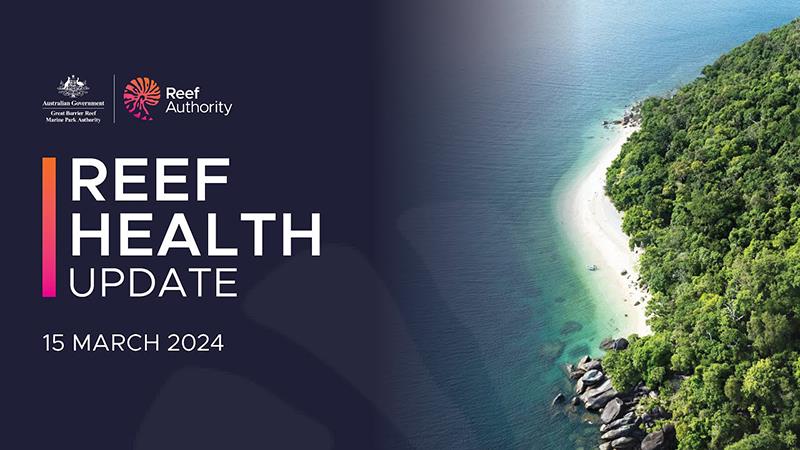
Great Barrier Reef health update - 15 March 2024
by GBRMPA 17 Mar 2024 05:55 UTC

Great Barrier Reef health update - 15 March 2024 © Great Barrier Reef Marine Park Authority
This week in-water surveys are continuing, to determine the effects of coral bleaching at a range of depths, so we can better understand the impact of this widespread coral bleaching event across the Marine Park.
Aerial surveys to date have observed variable but widespread coral bleaching across two-thirds of the Marine Park. Aerial surveys across the remainder of the Marine Park, the far northern region from Lizard Island to the Torres Strait, and in the offshore southern Swains region, and the offshore southern region have not been able to occur due to weather conditions. These aerial surveys will continue as soon as it's safe to do so.
Temperature
Thermal stress continues to accumulate across the Marine Park, however sea surface temperatures have started to decrease as a result of high winds and swell.
Despite some cooler conditions, thermal stress continues, with sea surface temperatures remaining above the long-term average across the Marine Park.
Sea surface temperatures across the Marine Park range from 0-2.5 degreesC above the long-term monthly average, with the highest anomalies in the northern and southern region.
A low-pressure system offshore Mackay, and several weak low-pressure systems along northern Australia are expected to bring further cloud cover, heavy rainfall and elevated wind and wave action across the Marine Park, potentially having a cooling effect in these areas.
Rainfall
The greatest weekly rainfall totals in the past week were recorded in the Wet Tropics with over 400 mm and up to 400 mm in the Cape York Catchment Region. This has resulted in above average streamflow within these catchments that drain into the Marine Park.
This is expected to continue to reduce salinity in coastal and inshore areas between Cardwell and Cape Melville, and north of Lockhart River.
Reef health
A total of 107 in-water surveys were conducted in the Marine Park between 6 March-13 March. In the southern region, mostly severe impacts of coral bleaching and minor impacts of damage (e.g. anchor damage, fishing lines etc.) and disease were recorded.
Mostly moderate impacts of bleaching, and minor impacts of damage and disease were found in the central region. Surveys are also being conducted in the northern region that will be reported in the coming weeks.
An outbreak of the coral-eating crown-of-thorns starfish continues at some reefs in the offshore southern region and isolated outbreaks remain on a few reefs offshore in the Central Region. There are also increasing densities of crown-of-thorn starfish near Lizard Island and offshore Port Douglas.
Reef management
The Reef Authority continues to monitor conditions on the Reef and to plan, prepare and respond accordingly to any events that occur.
The Reef Authority is working closely with the Australian Institute of Marine Science and the broader observer network to complete further surveys to get a better understanding of the full extent and severity of coral bleaching across the Great Barrier Reef.
Staff from the Australian and Queensland government are out patrolling the Marine Park as part of the Reef Joint Field Management Program, monitoring and ensuring zoning laws and Marine Park rules are being followed.
This week, our team of specialists in the crown-of-thorns starfish control program met to review where crown-of-thorns starfish outbreaks are occurring, and how we can target the control program to reduce crown-of-thorns starfish predation on reefs that have been affected by recent coral bleaching and cyclone impacts.
We'll continue to target our management programs in the areas that need them most in the coming weeks and as we get more data from in water and aerial surveys.
Visit our website for more information.